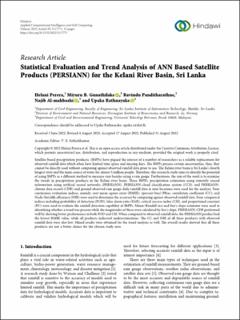| dc.contributor.author | Perera, Helani | |
| dc.contributor.author | Gunathilake, Miyuru | |
| dc.contributor.author | Panditharathne, Ravindu | |
| dc.contributor.author | Al-mahbashi, Najib | |
| dc.contributor.author | Rathnayake, Upaka | |
| dc.date.accessioned | 2022-10-26T07:12:53Z | |
| dc.date.available | 2022-10-26T07:12:53Z | |
| dc.date.created | 2022-09-30T09:44:54Z | |
| dc.date.issued | 2022-08-31 | |
| dc.identifier.citation | Applied Computational Intelligence and Soft Computing. 2022, 2022 . | en_US |
| dc.identifier.issn | 1687-9724 | |
| dc.identifier.uri | https://hdl.handle.net/11250/3028296 | |
| dc.description.abstract | Satellite-based precipitation products, (SbPPs) have piqued the interest of a number of researchers as a reliable replacement for observed rainfall data which often have limited time spans and missing days. The SbPPs possess certain uncertainties, thus, they cannot be directly used without comparing against observed rainfall data prior to use. The Kelani river basin is Sri Lanka’s fourth longest river and the main source of water for almost 5 million people. Therefore, this research study aims to identify the potential of using SbPPs as a different method to measure rain besides using a rain gauge. Furthermore, the aim of the work is to examine the trends in precipitation products in the Kelani river basin. Three SbPPs, precipitation estimation using remotely sensed information using artificial neural networks (PERSIANN), PERSIANN-cloud classification system (CCS), and PERSIANN-climate data record (CDR) and ground observed rain gauge daily rainfall data at nine locations were used for the analysis. Four continuous evaluation indices, namely, root mean square error (RMSE), (percent bias) PBias, correlation coefficient (CC), and Nash‒Sutcliffe efficiency (NSE) were used to determine the accuracy by comparing against observed rainfall data. Four categorical indices including probability of detection (POD), false alarm ratio (FAR), critical success index (CSI), and proportional constant (PC) were used to evaluate the rainfall detection capability of SbPPs. Mann‒Kendall test and Sen’s slope estimator were used to identifying whether a trend was present while the magnitudes of these were calculated by Sen’s slope. PERSIANN-CDR performed well by showing better performance in both POD and CSI. When compared to observed rainfall data, the PERSIANN product had the lowest RMSE value, while all products indicated underestimations. The CC and NSE of all three products with observed rainfall data were also low. Mixed results were obtained for the trend analysis as well. The overall results showed that all three products are not a better choice for the chosen study area. | en_US |
| dc.language.iso | eng | en_US |
| dc.publisher | Hindawi | en_US |
| dc.rights | Navngivelse 4.0 Internasjonal | * |
| dc.rights.uri | http://creativecommons.org/licenses/by/4.0/deed.no | * |
| dc.title | Statistical Evaluation and Trend Analysis of ANN Based Satellite Products (PERSIANN) for the Kelani River Basin, Sri Lanka | en_US |
| dc.title.alternative | Statistical Evaluation and Trend Analysis of ANN Based Satellite Products (PERSIANN) for the Kelani River Basin, Sri Lanka | en_US |
| dc.type | Peer reviewed | en_US |
| dc.type | Journal article | en_US |
| dc.description.version | publishedVersion | en_US |
| dc.rights.holder | © 2022 Helani Perera et al. | en_US |
| dc.source.pagenumber | 12 | en_US |
| dc.source.volume | 2022 | en_US |
| dc.source.journal | Applied Computational Intelligence and Soft Computing | en_US |
| dc.identifier.doi | 10.1155/2022/2117771 | |
| dc.identifier.cristin | 2057026 | |
| dc.source.articlenumber | 2117771 | en_US |
| cristin.ispublished | true | |
| cristin.fulltext | original | |
| cristin.qualitycode | 1 | |

